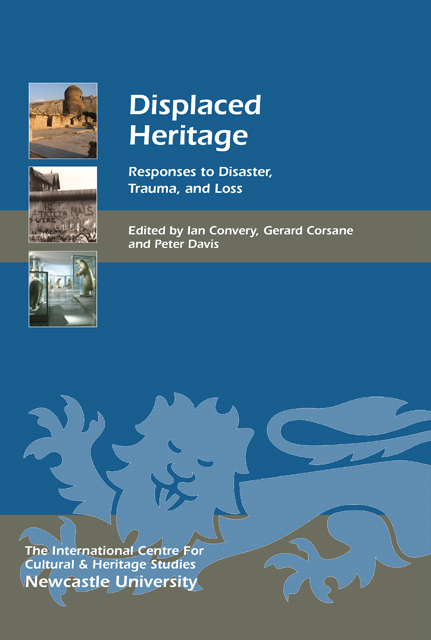Book contents
- Frontmatter
- Contents
- List of Illustrations
- Acknowledgments
- List of Abbreviations
- Preface
- Introduction
- Displaced Heritage: Histories and Tourism
- Displaced Heritage: Trauma, Confinement and Loss
- Displaced Heritage: Lived Realities, Local Experiences
- Displaced Natural Heritage
- Endpiece
- List of Contributors
- Index
- Heritage Matters
3 - Memorialisation in Eastern Germany: Displacement, (Re)placement and Integration of Macro- and Micro-Heritage
Published online by Cambridge University Press: 24 February 2023
- Frontmatter
- Contents
- List of Illustrations
- Acknowledgments
- List of Abbreviations
- Preface
- Introduction
- Displaced Heritage: Histories and Tourism
- Displaced Heritage: Trauma, Confinement and Loss
- Displaced Heritage: Lived Realities, Local Experiences
- Displaced Natural Heritage
- Endpiece
- List of Contributors
- Index
- Heritage Matters
Summary
Introduction
Histories of disaster, trauma and loss are an integral part of examining Germany’s 20th century heritage. In this chapter three heritage sites which represent these aspects of displacement are introduced: firstly, the Frauenkirche in Dresden as a place embodying human-made disaster; secondly, the Zeithain Grove of Honour as a site of trauma; and finally, the Betonzeitschiene – Plattenbau Micromuseum as a space of loss. The Dresden Frauenkirche is perhaps Saxony’s most well-known general tourist attraction, celebrating the city’s Baroque architectural history, but also a place of memory following the disaster of the Allied firebombing of Dresden during World War II. This occurred on 13 and 14 February 1945, reducing the church to heaps of rubble. It was rebuilt during 1992–2005 following reunification, having been left as a ruin during the German Democratic Republic (GDR) period. The Zeithain Grove of Honour and Micromuseum are a commemoration and interpretation of the trauma of a former World War II prisoner of war (POW) camp housing Allied soldiers. The Betonzeitschiene – Plattenbau Micromuseum consisted of a spatial, architectural installation commemorating the history of the Plattenbau (prefabricated concrete panel apartment blocks) as an architectural form and local industry.
This chapter considers what constitutes heritage against notions of displacement and (re) placement in relation to: disaster and recovery; destruction and regeneration; trauma and reconciliation; loss and renewal; remembering and forgetting; place and time; past, present and future. Underlying these notions are the shifting perceptions of what is, or is not, ‘worthy’ of preservation or memorialisation at any one moment in time; perceptions which are dependent on numerous political and public factors, themselves always in a state of flux. These issues are heightened in locations such as eastern Germany, which has undergone major political and social upheaval from the end of World War II, through the period of the German Democratic Republic (GDR) 1949–1990, reunification with the Federal Republic of Germany (West Germany), and right up to today. This chapter examines the changing nature of heritage memorialisation over time, using examples from the current eastern German state of Saxony. These examples of heritage memorialisation range from the ‘macro’ (nationally and internationally recognised symbolic heritage) to the ‘micro’ (niche interest and/or ‘unpopular’ heritage).
The Frauenkirche is an example of macro-level heritage, widely recognised for both its architectural significance and as a post-reunification identity marker for Germany.
- Type
- Chapter
- Information
- Displaced HeritageResponses to Disaster, Trauma, and Loss, pp. 29 - 40Publisher: Boydell & BrewerPrint publication year: 2014
- 1
- Cited by



